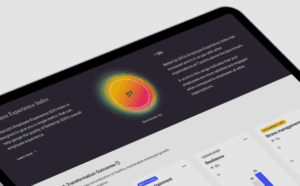Home / Blog / The Best Conversion Rate Optimization Tools In 2024
The Best Conversion Rate Optimization Tools In 2024
Published: July 14, 2024
Share on LinkedIn Share on Twitter Share on Facebook Click to print Click to copy url

Contents Overview
If you are on the hunt to find the best Conversion Rate Optimization (CRO) tools for your website, you have come to the right place. With so many CRO tools available, choosing the right tools for your website and business goals can be challenging.
This post will explore the four categories of CRO tools, the step-by-step process for implementing a CRO program, and an analysis of the popular CRO tools. Applying the recommendations in this post can help you effectively use the capabilities of CRO tools.
Understanding Conversion Rate Optimization and Its Importance
Conversion Rate Optimization refers to increasing the number of website visitors who complete an action on your site. Whether that action might be making a purchase, submitting a form, or signing up for a newsletter, implementing CRO gives you the competitive edge. CRO allows you to understand the user experience on your site and identify reasons why users might not be converting.
The key to success in CRO is leveraging the power of Conversion Rate Optimization tools. CRO tools collect data about your website and its users, enabling you to identify and test opportunities to increase conversion rates. Using CRO tools effectively can turn your website visitors into loyal customers.
The Four Pillars of Conversion Rate Optimization Tools
Conversion rate optimization tools fall into four categories:
- Web analytics tools
- Behavior analytics tools
- CRO testing tools
- Lead capture tools
Web Analytics Tools:
Web analytics tools collect information, such as user demographics, traffic sources, webpage performance, and key engagement metrics like conversion rate. The data from these website analytics tools assist in the Conversion Rate Optimization process.
They allow a conversion rate optimization specialist to identify the web pages experiencing low conversion rates. The tools also provide insight into your target audience’s interests, which can help guide the CRO strategies you create.
Trending website analytics tools include Google Analytics 4, Semrush, and Adobe Analytics.

Behavior Analytics Tools:
Behavior analytics tools focus on user behavior and engagements on a site. They can help you identify common user patterns on your site, such as places where users encounter difficulties. Heatmap tools are a great way to understand the user journey on your site.
Using a heatmap tool like Hotjar, Crazy Egg, or Microsoft Clarity, you can learn where the most popular and least popular clicks occur, see how far users are scrolling on your website, and identify where dead clicks happen.
All of this information can be instrumental in the CRO process as you can identify the best places to put calls to action and fix the roadblocks stopping users from converting.



CRO Testing Tools:
Conversion rate optimization testing tools allow you to discover the versions of your site that will lead to the most conversions. You can run an A/B test to compare the performance of two web pages.
Webpage A is the original webpage, and webpage B is the new version of the page that is tested and evaluated to see if it performs better or worse.
A/B testing tools like VWO, Crazy Egg, and AB Tasty can help you identify conversion obstacles and determine the site setup that will convert the most.



Lead Capture Tools:
Lead capture tools help you collect information about potential customers interested in your services. These tools use methods such as pop-up forms to gather leads and information about customers. You can use lead capture tools to determine which interested customers are most likely to convert and who you should focus on targeting. Popular lead capture tools include OptinMonster, Hello Bar, and Leadpages.



Step-by-Step Guide to Implementing a Conversion Rate Optimization Program
Here at Go Fish Digital, we developed a step-by-step process for implementing a conversion rate optimization program.
Step 1: Identify Factors Driving Visitors
The first step in finding the best CRO program for your business is to identify why users visit your site. Ask yourself: are there certain pages or sections of your site that users are drawn to?
Understanding user intent for your website can help facilitate CRO. Using the tools mentioned in the four pillars section, you can make website changes, such as strategically placing CTAs or optimizing a popular landing page, that will ultimately lead to conversions.
Step 2: Pinpoint Conversion Hindrances
You can use CRO tools such as heatmap and session recording tools to see the places during a user’s site journey where a user faces a hurdle in converting and decides to leave the site.
You will likely start to see similar patterns where users are getting stuck, and you can develop improvements based on these patterns to increase conversions.
Step 3: Discovering Persuasive Factors
Since CRO tools allow you to understand users’ interests and behaviors on your site, you can use this information to discover the most effective ways to increase conversions. Website analytics tools like GA4 can show you the places that receive the most and the fewest conversions.
From there, you can compare the differences between the places getting the most and least conversions. With the help of tools like heatmaps and session recordings, you can further identify why certain places receive higher conversion rates. Based on these discoveries, you can implement strategies to compel users to convert in areas that previously received lower conversion rates.
Step 4: Implementing and Testing Changes
Now that you have identified the changes needed to increase conversions, you are ready to complete the final step of testing and implementing these adjustments.
You can use A/B testing tools to experiment with these changes and determine if they will lead to improvements. If you find the changes are successful, you can implement and monitor these changes using the tools that fall under the four pillars.
Comparing the Popular Conversion Rate Optimization Tools
While the CRO industry includes a variety of CRO tool options, here are some of the most popular CRO tools available.
Adobe Analytics is a multi-dimensional website analysis tool that tracks real-time data for your site. The conversion tracking features of Adobe Analytics allow you to monitor users’ journeys from when they first click to when they complete a conversion. Its attribution features can help you to identify where conversions are coming from. Adobe Analytics also conducts predictive analytics. By using machine learning to find patterns in user data, Adobe Analytics predicts future user behavior, such as the likelihood of completing a conversion.

Hotjar is a user behavior analysis tool. Its session recording and heatmap features can identify website design changes to improve user site experience. The tool also offers conversion tracking features like funnels and dashboards to help you identify low conversion rate areas on your site.

Crazy Egg is another helpful user behavior analysis tool that can improve your understanding of site engagement. Its heatmap features can help you identify the most and least popular places users engage with on your site. It also offers an A/B testing tool to help you determine the version of your site that will lead to the optimal conversion rate.

FullStory is a digital intelligence platform with tools to understand user interactions on a website. Its auto-capture technology allows you to gain a detailed analysis of how users interact with your site. FullStory can help you identify and solve usability issues on your site that will improve your optimization efforts.
Go Fish Digital’s Contribution to Conversion Rate Optimization
Go Fish Digital is here to help you in your CRO journey. Our agency offers CRO services that will turn your website visitors into loyal customers. Using the tools across all four pillars, we develop a personalized CRO strategy for your business. We identify the obstacles that prevent users from completing site conversions.
We also optimize key landing pages by establishing credibility with your site visitors. After discovering possible changes to improve CRO, we use comprehensive A/B testing to ensure we make the most effective changes. Our CRO services can increase your customer base and give you a competitive advantage. You can request a custom CRO proposal with us today for more information.
Conclusion
Conversion Rate Optimization tools allow you to unlock strategies for improving user experience and ultimately increasing the conversion rate on your website.
To implement an effective CRO program, you can follow our 4-step process of identifying factors driving visitors to your site, pinpointing conversion hindrances, discovering persuasive factors leading to conversions, and implementing and testing these changes.
Our CRO team’s expertise here at Go Fish Digital can help you navigate this CRO process and enhance your website to achieve optimal performance.
About Abby Reed
MORE TO EXPLORE
Related Insights
More advice and inspiration from our blog
How To Export Google Analytics Data To Excel
Google Analytics data organization and filter options can help you avoid...
Abby Reed| September 14, 2024
Best Training Courses for Google Analytics 4 (all different levels)
If you are looking to get started using GA4 or ready...
Abby Reed| August 20, 2024
How To Set Up Google Analytics 4 Ecommerce Tracking
If your site involves ecommerce, there are metrics you want to...
Abby Shamblin| June 24, 2024





